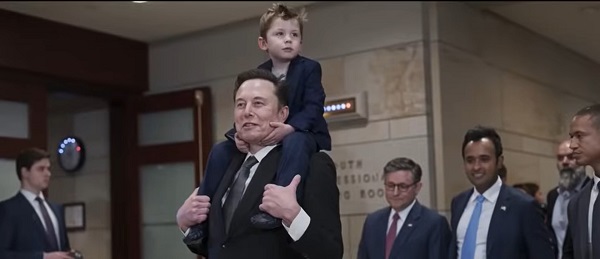Business
DOGE Must Focus On Big Picture To Achieve Big Change


From the Daily Caller News Foundation
By Jenny Beth Martin
President-elect Donald Trump’s new Department of Government Efficiency (DOGE) is wasting no time in laying the groundwork for its effort to cut the size and scope of government. That Elon Musk and Vivek Ramaswamy are the right men to lead this effort is beyond doubt — Musk famously slashed the workforce at Twitter after he bought it and Ramaswamy made shrinking the federal workforce the centerpiece of his campaign for president a year ago.
They know how to find cost savings, and they have shown they are not afraid to do so.
Visiting with congressional Republicans last week, Musk and Ramaswamy even declared they would be keeping a “naughty and nice” list of those who work with them to save taxpayer money and those who do not.
To that end — because who, especially at this time of year, doesn’t want to be on a “nice” list? — here are some thoughts.
First, they are going to have to look at the big picture. They won’t find the $2 trillion Musk pledged to save by focusing on the old standby, “waste, fraud, and abuse.” Yes, they are certainly going to find plenty of waste, fraud, and abuse in the Government Accountability Office (GAO) reports their staff will review, but that will not be enough.
To find the big savings, they are going to have to shrink not just the size of the federal government, but its scope. The federal government is not huge just because it spends money inefficiently, it is huge because it is doing things it has no business doing.
Second, they are going to have to take advantage of the fact that much of that huge government was never specifically authorized by the Congress. The federal behemoth was created by the mass of alphabet soup executive branch agencies that have for decades been imposing regulations that have the force of law, even though the Congress never approved them.
Reversing that is going to require taking a chain saw to federal regulations. And we will need a proportionally reduced federal workforce to match the reduced federal regulatory regime. That should not be a problem; huge numbers of federal employees still have not come back to work in their offices, even though the COVID-19 crisis ended years ago. The DOGE should recommend that any federal employee who refuses a directive to come back to work in the office should be terminated. That will save taxpayer money, too — a 10% cut in the federal workforce would yield about $40 billion in savings every year.
Third, recognize that to make permanent change, executive orders will not be enough — because executive orders can be reversed by the next president. Laws, on the other hand, can only be overturned with new action by the Congress and the president. That makes laws tougher to overturn.
One of the legislative changes that would serve the long-term interest in getting the federal government under control would be passage of the REINS Act, a proposed law that would require any federal agency that wanted to impose a new regulation that would have a significant impact on the economy to first gain approval from Congress in the form of an affirmative vote in both houses, and then the signature of the president. As I said when discussing this on my recent podcast with American Commitment’s Phil Kerpen, ‘Imagine that — Congress votes on something before it becomes law!”
A second legislative change that could help make a major difference would be reform of the civil service laws that govern the federal workforce. Musk and Ramaswamy are going to recommend significant elimination of positions in the federal workforce. Under the current system, it is significantly more difficult to remove employees than it is in the private sector — even employees who engage in insubordination or flagrantly breaking rules. And before you retort, “but the tradeoff they agree to, and that we must honor, is that civil service employees accept lower compensation in exchange for that greater job security,” a recent analysis by the Cato Institute shows that “the average federal civilian worker made $157,000 in wages and benefits in 2023, much higher than the average U.S. private sector wages and benefits of $94,000.”
Greater job security on top of higher compensation? That wasn’t the deal.
Rep. Barry Loudermilk (R-Ga.) introduced his MERIT Act in the last Congress. It was a proposed law that would have strengthened agency management’s power to remove poor employees, expedited timelines and made other reforms to bring the system closer to the private-sector model. Something along those lines could be extremely helpful as federal managers move to meet their reduced workforce needs.
The DOGE enterprise begins with broad public support — a recent poll conducted by McLaughlin & Associates for the organization I lead, Tea Party Patriots Action, shows that 71% of Americans support the creation of DOGE and 65% support firing government employees who do not return to their offices to work.
Musk and Ramaswamy have taken on a huge task, and they recognize the opportunity before them. By focusing on big-picture efforts to shrink the size and the scope of the federal government, they can help restore it to its constitutional moorings, with government officials in a smaller, less intrusive, less expensive government that is more responsive to the needs, desires, and authority of the citizens on whose behalf and in whose name they toil.
Jenny Beth Martin is honorary chairman of Tea Party Patriots Action.
Business
Fuelled by federalism—America’s economically freest states come out on top

From the Fraser Institute
Do economic rivalries between Texas and California or New York and Florida feel like yet another sign that America has become hopelessly divided? There’s a bright side to their disagreements, and a new ranking of economic freedom across the states helps explain why.
As a popular bumper sticker among economists proclaims: “I heart federalism (for the natural experiments).” In a federal system, states have wide latitude to set priorities and to choose their own strategies to achieve them. It’s messy, but informative.
New York and California, along with other states like New Mexico, have long pursued a government-centric approach to economic policy. They tax a lot. They spend a lot. Their governments employ a large fraction of the workforce and set a high minimum wage.
They aren’t socialist by any means; most property is still in private hands. Consumers, workers and businesses still make most of their own decisions. But these states control more resources than other states do through taxes and regulation, so their governments play a larger role in economic life.
At the other end of the spectrum, New Hampshire, Tennessee, Florida and South Dakota allow citizens to make more of their own economic choices, keep more of their own money, and set more of their own terms of trade and work.
They aren’t free-market utopias; they impose plenty of regulatory burdens. But they are economically freer than other states.
These two groups have, in other words, been experimenting with different approaches to economic policy. Does one approach lead to higher incomes or faster growth? Greater economic equality or more upward mobility? What about other aspects of a good society like tolerance, generosity, or life satisfaction?
For two decades now, we’ve had a handy tool to assess these questions: The Fraser Institute’s annual “Economic Freedom of North America” index uses 10 variables in three broad areas—government spending, taxation, and labor regulation—to assess the degree of economic freedom in each of the 50 states and the territory of Puerto Rico, as well as in Canadian provinces and Mexican states.
It’s an objective measurement that allows economists to take stock of federalism’s natural experiments. Independent scholars have done just that, having now conducted over 250 studies using the index. With careful statistical analyses that control for the important differences among states—possibly confounding factors such as geography, climate, and historical development—the vast majority of these studies associate greater economic freedom with greater prosperity.
In fact, freedom’s payoffs are astounding.
States with high and increasing levels of economic freedom tend to see higher incomes, more entrepreneurial activity and more net in-migration. Their people tend to experience greater income mobility, and more income growth at both the top and bottom of the income distribution. They have less poverty, less homelessness and lower levels of food insecurity. People there even seem to be more philanthropic, more tolerant and more satisfied with their lives.
New Hampshire, Tennessee, and South Dakota topped the latest edition of the report while Puerto Rico, New Mexico, and New York rounded out the bottom. New Mexico displaced New York as the least economically free state in the union for the first time in 20 years, but it had always been near the bottom.
The bigger stories are the major movers. The last 10 years’ worth of available data show South Carolina, Ohio, Wisconsin, Idaho, Iowa and Utah moving up at least 10 places. Arizona, Virginia, Nebraska, and Maryland have all slid down 10 spots.
Over that same decade, those states that were among the freest 25 per cent on average saw their populations grow nearly 18 times faster than those in the bottom 25 per cent. Statewide personal income grew nine times as fast.
Economic freedom isn’t a panacea. Nor is it the only thing that matters. Geography, culture, and even luck can influence a state’s prosperity. But while policymakers can’t move mountains or rewrite cultures, they can look at the data, heed the lessons of our federalist experiment, and permit their citizens more economic freedom.
Automotive
Politicians should be honest about environmental pros and cons of electric vehicles

From the Fraser Institute
By Annika Segelhorst and Elmira Aliakbari
According to Steven Guilbeault, former environment minister under Justin Trudeau and former member of Prime Minister Carney’s cabinet, “Switching to an electric vehicle is one of the most impactful things Canadians can do to help fight climate change.”
And the Carney government has only paused Trudeau’s electric vehicle (EV) sales mandate to conduct a “review” of the policy, despite industry pressure to scrap the policy altogether.
So clearly, according to policymakers in Ottawa, EVs are essentially “zero emission” and thus good for environment.
But is that true?
Clearly, EVs have some environmental advantages over traditional gasoline-powered vehicles. Unlike cars with engines that directly burn fossil fuels, EVs do not produce tailpipe emissions of pollutants such as nitrogen dioxide and carbon monoxide, and do not release greenhouse gases (GHGs) such as carbon dioxide. These benefits are real. But when you consider the entire lifecycle of an EV, the picture becomes much more complicated.
Unlike traditional gasoline-powered vehicles, battery-powered EVs and plug-in hybrids generate most of their GHG emissions before the vehicles roll off the assembly line. Compared with conventional gas-powered cars, EVs typically require more fossil fuel energy to manufacture, largely because to produce EVs batteries, producers require a variety of mined materials including cobalt, graphite, lithium, manganese and nickel, which all take lots of energy to extract and process. Once these raw materials are mined, processed and transported across often vast distances to manufacturing sites, they must be assembled into battery packs. Consequently, the manufacturing process of an EV—from the initial mining of materials to final assembly—produces twice the quantity of GHGs (on average) as the manufacturing process for a comparable gas-powered car.
Once an EV is on the road, its carbon footprint depends on how the electricity used to charge its battery is generated. According to a report from the Canada Energy Regulator (the federal agency responsible for overseeing oil, gas and electric utilities), in British Columbia, Manitoba, Quebec and Ontario, electricity is largely produced from low- or even zero-carbon sources such as hydro, so EVs in these provinces have a low level of “indirect” emissions.
However, in other provinces—particularly Alberta, Saskatchewan and Nova Scotia—electricity generation is more heavily reliant on fossil fuels such as coal and natural gas, so EVs produce much higher indirect emissions. And according to research from the University of Toronto, in coal-dependent U.S. states such as West Virginia, an EV can emit about 6 per cent more GHG emissions over its entire lifetime—from initial mining, manufacturing and charging to eventual disposal—than a gas-powered vehicle of the same size. This means that in regions with especially coal-dependent energy grids, EVs could impose more climate costs than benefits. Put simply, for an EV to help meaningfully reduce emissions while on the road, its electricity must come from low-carbon electricity sources—something that does not happen in certain areas of Canada and the United States.
Finally, even after an EV is off the road, it continues to produce emissions, mainly because of the battery. EV batteries contain components that are energy-intensive to extract but also notoriously challenging to recycle. While EV battery recycling technologies are still emerging, approximately 5 per cent of lithium-ion batteries, which are commonly used in EVs, are actually recycled worldwide. This means that most new EVs feature batteries with no recycled components—further weakening the environmental benefit of EVs.
So what’s the final analysis? The technology continues to evolve and therefore the calculations will continue to change. But right now, while electric vehicles clearly help reduce tailpipe emissions, they’re not necessarily “zero emission” vehicles. And after you consider the full lifecycle—manufacturing, charging, scrapping—a more accurate picture of their environmental impact comes into view.
-

 Bruce Dowbiggin1 day ago
Bruce Dowbiggin1 day agoWayne Gretzky’s Terrible, Awful Week.. And Soccer/ Football.
-

 espionage15 hours ago
espionage15 hours agoWestern Campuses Help Build China’s Digital Dragnet With U.S. Tax Funds, Study Warns
-

 Focal Points6 hours ago
Focal Points6 hours agoCommon Vaccines Linked to 38-50% Increased Risk of Dementia and Alzheimer’s
-

 Opinion1 day ago
Opinion1 day agoThe day the ‘King of rock ‘n’ roll saved the Arizona memorial
-

 Agriculture1 day ago
Agriculture1 day agoCanada’s air quality among the best in the world
-

 Business13 hours ago
Business13 hours agoCanada invests $34 million in Chinese drones now considered to be ‘high security risks’
-

 Health4 hours ago
Health4 hours agoThe Data That Doesn’t Exist
-

 Economy14 hours ago
Economy14 hours agoAffordable housing out of reach everywhere in Canada





